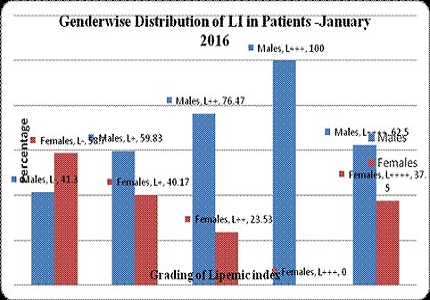Lipemic index a tool to measure lipemia
Abstract
Introduction: Lipemia is represented as turbidity in the serum or plasma which becomes evident before the analytical process. It is mainly caused by large particles of lipoproteins such as chylomicrons or VLDL, the main lipid component of which is triglyceride. Lipemic interference is commonly found in routine clinical chemistry tests. It can, not only influence measurements of analytes, but can also cause false increase or decrease intheir levels. The aim was to use Lipemic index (LI) as an automated determinant of lipemia in venous blood specimens sent to our clinical chemistry laboratory and measure the extent of turbidity.
Methods: The study was conducted in Clinical Biochemistry laboratory in the month of January 2016.Total of 809 samples were collected and lipemic index (LI) was estimated in autoanalyzer, transasia XL-640.LI values were categorized from L- to L++++.Percentage of sample in each category was calculated.
Results: Most of our patients (68.23%) had LI <10,that is L-.A considerable group (28.3%) were in L+ range. Highest degree of lipemia was observed in 0.98% patients. Females had less turbid samples as compared to men. A greater proportion of women (58.7%) had LI <10 as compared to men (41.3%).From L+ to L++++ ,men had higher LI as compared to women.
Conclusion: Lipemic index estimation ensures that the sample is fit for analysis. The use of automated LI estimation overcomes the limitations associated with visual estimation by providing a more objective and accurate estimate of lipemia.
Downloads
References
2. Lippi G, Becan-McBride K, Behúlová D, Bowen RA, Church S, Delanghe J, Grankvist K, Kitchen S, Nybo M, Nauck M, Nikolac N, Palicka V, Plebani M, Sandberg S, Simundic AM. Preanalytical quality improvement: in quality we trust. ClinChem Lab Med. 2013 Jan;51(1):229-41. doi: 10.1515/cclm-2012-0597. [PubMed]
3. Jabbar J, Siddiqui I, Raza SQ, Baig A. To compare the total cholesterol and HDL-cholesterol before and after ultra-centrifugation in lipemic samples.J Pak Med Assoc. 2005 Jun;55(6):239-42. [PubMed]
4. Simundic AM, Nikolac N, Ivankovic V, Ferenec-Ruzic D, Magdic B, Kvaternik M, Topic E. Comparison of visual vs. automated detection of lipemic, icteric and hemolyzed specimens: can we rely on a human eye? ClinChem Lab Med 2009;47:1361-5. [PubMed]
5. Vermeer HJ, Thomassen E, de Jonge N. Automated processing of serum indices used for interference detection by the laboratory information system. ClinChem 2005;51:244-7. [PubMed]
6. Seidell JC, Cigolini M, Charzewska J, Ellsinger BM, Björntorp P, Hautvast JG, Szostak W. Fat distribution and gender differences in serum lipids in men and women from four European communities.Atherosclerosis. 1991 Apr;87(2-3):203-10.
7. Kazmierczak SC. Hemolysis, Lipemia, and High Bilirubin: Effect on Laboratory Tests. In: Dasgupta A, Sepulveda JL, eds. Accurate Results in the Clinical Laboratory: A Guide to ErrorDetection and Correction. Amsterdam: Elsevier 2013; p. 53-62.
8. Salvagno GL, Lippi G, Gelati M, Guidi GC. Hemolysis, lipaemia and icterus in specimens for arterial blood gas analysis. ClinBiochem. 2012 Mar;45(4-5):372-3. doi: 10.1016/j.clinbiochem.2011.12.005. Epub 2011 Dec 19. [PubMed]
9. Fliser E, Jerkovic K, Vidovic T, Gorenjak M. Investigation of unusual high serum indices for lipemia in clear serum samples on siemensanalysers dimension. Biochem Med (Zagreb). 2012;22(3):352-62. [PubMed]
10. Munnix ICA, Raijmakers MTM, Oosterhuis WP, Kleinveld HA.Detection of a monoclonal gammopathy by lipemiaindex measurement. Ned TijdschrKlinChemLabgeneesk 2009;34:248-9.
11. Kroll MH, McCudden CR. Endogenous Interferences in Clinical Laboratory Tests. Icteric, Lipemic and Turbid Samples. Berlin, Boston: De Gruyter, 2012.
12. Clinical Laboratory Standards Institute. Hemolysis, Icterus, and Lipemia/Turbidity Indices as Indicators of Interference in Clinical Laboratory Analysis; Approved Guideline. CLSIC56-A document. Clinical Laboratory Standards Institute,Wayne, Pennsylvania, USA, 2012.
13. Calmarza P, Cordero J. Lipemia interferences in routine clinical biochemical tests. Biochem Med (Zagreb). 2011;21(2):160-6. [PubMed]
14. Sharma A, Anderson K, Baker JW. Flocculation of serum lipoproteins with cyclodextrins: application to assay of hyperlipidemic serum. Clin Chem. 1990 Mar;36(3):529-32.



 OAI - Open Archives Initiative
OAI - Open Archives Initiative


